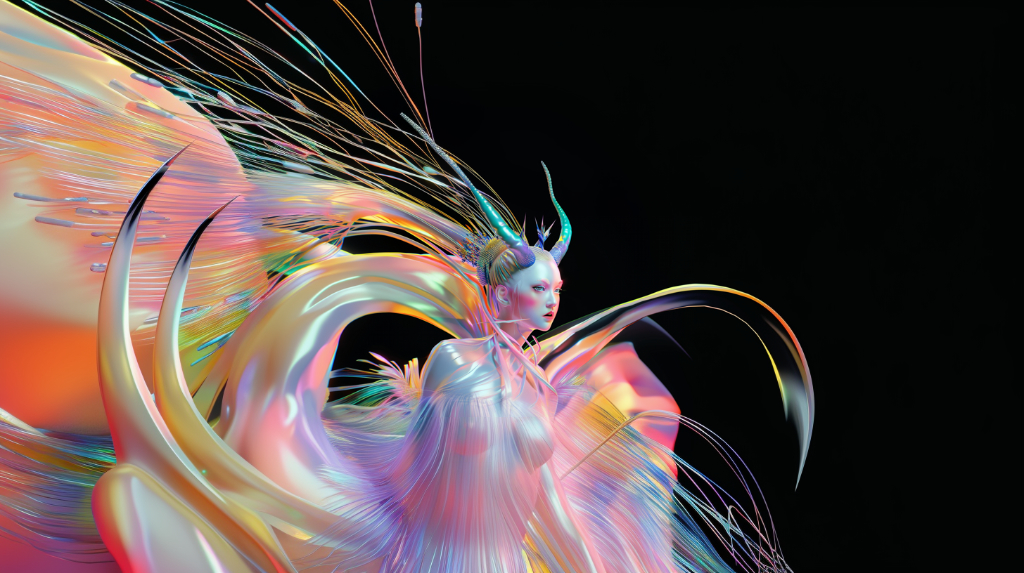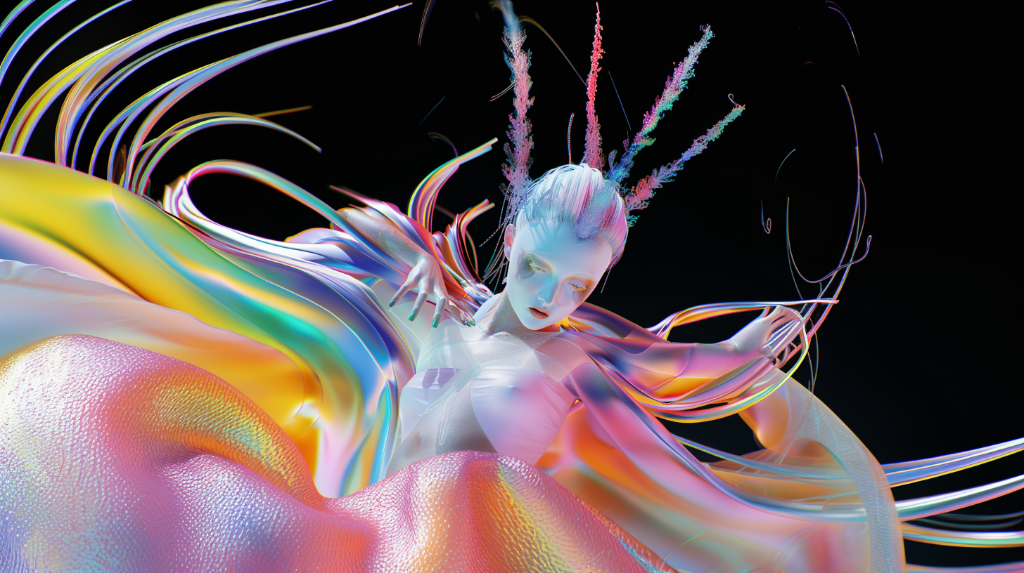Interview by Irem Erkin

Jumoke Fernandez is a remarkable self-taught creative driven by a passion for merging design with cutting-edge technology. She received home education from a young age, with her mother as an art teacher and her father as a musician and software developer. They designed her educational curriculum, offering a well-rounded mix of computer sciences and traditional arts, such as life drawing and art history. Growing up in the Internet era, her passion for digital art blossomed at 17 when she encountered post-Internet art.
As a young digital visionary, Jumoke Fernandez is dedicated to knowledge and artistic expression. Her extensive background spans gaming, augmented reality, blockchain, and entertainment, giving her a unique perspective on her work. Specialising in digital art for mobile games and entertainment applications, Jumoke immerses herself in each project’s lore and style, effortlessly incorporating her creations into existing worlds or pioneering new ones.
Embracing the latest technological advancements, including artificial intelligence, Jumoke Fernandez uses a diverse range of tools, such as Stable Diffusion and Midjourney, to craft mesmerising visuals and train custom models to suit the precise demands of each project. Her enthusiasm for transformative technologies drives her to explore new possibilities and break the boundaries of artistic expression in the digital age.
In addition to her creative endeavours, Fernandez is committed to sharing her expertise through lectures at academic institutions such as The New Centre for Research & Practice and developing educational platforms to empower aspiring creatives. Her ability to predict, learn, and execute creative trends makes her an invaluable asset for any project seeking to impact the digital ecosystem. Dedicated to ethical and sustainable practices, she envisions a future where AI enhances rather than replaces human creativity, advocating for transparency and inclusivity in its application.





How does your diverse background contribute to your unique perspective in your work?
The diversity of my background—especially academically as an ex-homeschooler—enriches my creative perspective by enabling a multifaceted and experimental approach to creativity. My practice prioritises exploration and playful openness, which informs my commercial work.
Technology plays a central part in your work as a tool and motif in the resulting images. With projects like body clearance, in what ways do you see technology as shaping not only our bodies but also our identity more widely?
We have all experienced the transformative nature of technology and digital media in viewing our bodies and identities. From ‘mewing’ to ‘Meitu,’ all social media users’ psyches are at the whim of algorithms, which can be positive or negative. Even though we are heavily involved with technology, there is still a discrepancy between the digital and real realms.
I’m particularly interested in the next evolution of this topic, especially in relation to the advancements of AI and, in the future, spatial computing. One example would be in my practice. I have created a lot of AI-generated imagery of myself, and I realised that perhaps in 30 or 40 years, I may be unable to remember which images were real and which were not.
The thought of being in a more vulnerable elderly state and being shown this synthetic media while not being able to recall if this event truly happened was quite jarring for me. There’s no framework or best practice for what will come out of this technology, and we need to be hyper-vigilant and create our own solutions.
What sparked your interest in AI-driven visual storytelling? Can you share any personal experiences or inspirations that have motivated and fueled your passion in this field?
My love for storytelling stems mainly from my interest in gaming and digital communities. I want to explore new territories both technologically and visually. I was always hyper-fixated on dreamy fantasy worlds, such as those in books, anime, games, etc. Narratives are important, but more important for me is general world-building; narrative and storytelling are only a part of that.
How much autonomy do you grant AI in your creative process, and how does it collaborate with your artistic vision? In what ways do you find collaboration with AI enriching or challenging?
It depends very much on the project; sometimes, I have an obvious outcome in mind, and other times, I use image generation tools as a ‘ping pong’ partner to get to the final results – starting with an initial thought or concept and iterating until I find something that I like, then refining that output and direction. It can be pretty challenging when you have a specific result in mind, especially when you want to play with surreal imagery; with popular image-generation tools, the control is just not there. I prefer to think of these tools as collaborating with another person.
When I work with artists, they always bring their own flair. I can guide them and iterate indefinitely, but I can never completely control how another creative executes something. You pick your tools based on their strengths and style, as you would pick a collaborator on a project.
As you collaborate with major brands, how do you perceive the sector’s response to syntography?
There is an incredible amount of interest and many open questions. For most industries, the current technology can already provide solutions very well; however, some industries still need to question how to implement the technology helpfully. Let’s think, for example, about a makeup brand; they can use AI to create a packshot for the physical product – no problem – but in terms of model photography, there is currently no clear-cut solution.
When you have a swatch of lipstick on an arm, the colour must show accurately on several skin tones; it’s not as simple as selling wall paint. That’s not even starting to get into the complexities of accurately portraying glitters and shimmers; there is a lot of love and craftsmanship put into those formulas, and AI currently does not provide an easy solution for that industry.
Gaming and expanded realities push narrative and storytelling into all sorts of new and different territories. What is your personal experience about it? And where do you see these new forms of narratives moving into artistic practices?
I love gaming as a creative medium but also as a player. Narrative-heavy games have been around since the 80s, and it’s amazing to see brands and wider audiences adopt this medium. It has fully transitioned from nerd to normal at this point. Of course, narrative and storytelling have fantastic elements of engagement and interactivity, which are mostly not present in other narrative mediums like films or books. It also opens many doors regarding collective narrative experiences, multiplayer, and building real communities within narratives.
I was a heavy MMORPG player in my teens, and being part of a world for years and building real relationships is still magical and surreal in my mind. Even without this element built in, there is nothing more fun for me than playing a video game with someone. Gaming as an engagement technique just gets bigger and bigger; even Instagram is gamified now, rewarding its users with achievements. I think it will only permeate more into other elements of our lives over the next few years.
As a lecturer at The New Centre for Research & Practice, how do you actively contribute to the education and empowerment of aspiring creatives?
At The New Centre for Research & Practice, I actively engaged with students to demystify the complexities of Generative AIart and encourage a hands-on approach to learning. Through talks and mentoring, I aim to empower aspiring creatives by providing them the tools and knowledge to explore and innovate confidently within the digital realm.
What is your vision for a future where AI enhances human creativity while maintaining ethical standards? Do you take specific actions or initiatives to promote transparency and inclusivity in AI applications?
My vision for the future involves a synergy between AI and human creativity, where humans make critical decisions. Creatives shouldn’t fear these tools. Our real value is not in making minor adjustments like ‘making the logo bigger’, but in the overarching concepts and experiences we craft in every project. That human touch is still essential when integrating AI into our work.
The dystopian future, where machines create images autonomously, isn’t here—yet. The genuine concern should be the potential for AI to analyse vast amounts of data in real-time, making decisions to optimise engagement beyond the capabilities of a team of creatives and strategists. As creatives, we must be vigilant and assert the irreplaceable value of human judgment and creativity in an increasingly automated world.
Additionally, regarding ethical biases, as a creative, not a lawyer, my primary focus isn’t the legal aspects. Still, biased and discriminatory content within these systems is undeniably troubling. Ideally, users would possess the media literacy needed to identify and counteract these biases since they curate the content. For instance, even if an AI tool offers various gender and ethnicity options to illustrate a doctor, the final choice rests with the user, underscoring the need for personal responsibility in combating bias.
I prioritise educating and onboarding creatives into this ecosystem. Our presence in the discourse can be a powerful tool to advocate for more transparent systems. In my work, I am also a big fan of open-source technology, and I would love to see open-source become the future standard.
What is your chief enemy of creativity?
Complacency is the chief enemy of creativity. Remaining within one’s comfort zone or succumbing to repetitive patterns stifles innovation and growth.
You couldn’t live without…
Art of Noise [1].





